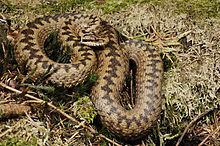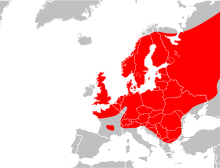| Common European adder | |
|---|---|

| |
| Scientific classification | |
| Domain: | Eukaryota |
| Kingdom: | Animalia |
| Phylum: | Chordata |
| Class: | Reptilia |
| Order: | Squamata |
| Suborder: | Serpentes |
| Family: | Viperidae |
| Genus: | Vipera |
| Species: | V. berus
|
| Binomial name | |
| Vipera berus | |

| |
| Synonyms[2] | |
|
IMG_1254.jpeg (1) Species synonymy
| |
Vipera berus, also known as the common European adder[3] and the common European viper,[4] is a species of venomous snake in the family Viperidae. The species is extremely widespread and can be found throughout much of Europe, and as far as East Asia.[2] There are three recognised subspecies.
Known by a host of common names including common adder and common viper, the adder has been the subject of much folklore in Britain and other European countries.[5] It is not regarded as especially dangerous;[3][page needed] the snake is not aggressive and usually bites only when really provoked, stepped on, or picked up. Bites can be very painful, but are seldom fatal.[6] The specific name, berus, is Neo-Latin and was at one time used to refer to a snake, possibly the grass snake, Natrix natrix.[7]
The common adder is found in different terrains, habitat complexity being essential for different aspects of its behaviour. It feeds on small mammals, birds, lizards, and amphibians, and in some cases on spiders, worms, and insects. The common adder, like most other vipers, is ovoviviparous. Females breed once every two or three years, with litters usually being born in late summer to early autumn in the Northern Hemisphere. Litters range in size from three to 20 with young staying with their mothers for a few days. Adults grow to a total length (including tail) of 60 to 90 cm (24 to 35 in) and a mass of 50 to 180 g (1.8 to 6.3 oz)[citation needed]. Three subspecies are recognised, including the nominate subspecies, Vipera berus berus described here.[8] The snake is not considered to be threatened, though it is protected in some countries.
- ^ Munkhbayar, K.; Rustamov, A; Orlov, N.L.; Jelić, D.; Meyer, A.; Borczyk, B.; Joger, U.; Tomović, L.; Cheylan, M.; Corti, C.; Crnobrnja-Isailović, J.; Vogrin, M.; Sá-Sousa, P.; Pleguezuelos, J.; Sterijovski, B.; Westerström, A.; Schmidt, B.; Sindaco, R.; Borkin, L.; Milto, K. & Nuridjanov, D. (2021). "Vipera berus". IUCN Red List of Threatened Species. 2021: e.T47756146A743903. doi:10.2305/IUCN.UK.2021-3.RLTS.T47756146A743903.en. Retrieved 8 August 2023.
- ^ a b McDiarmid RW, Campbell JA, Touré TA (1999). Snake Species of the World: A Taxonomic and Geographic Reference, Volume 1. Washington, District of Columbia: Herpetologists' League. ISBN 1-893777-00-6 (series). ISBN 1-893777-01-4 (volume).
- ^ a b Mallow D, Ludwig D, Nilson G (2003). True Vipers: Natural History and Toxinology of Old World Vipers. Malabar, Florida: Krieger Publishing Company. ISBN 0-89464-877-2.
- ^ Stidworthy J (1974). Snakes of the World. New York: Grosset & Dunlap Inc. 160 pp. ISBN 0-448-11856-4.
- ^ "Everyday Adders – the Adder in Folklore". The Herpetological Conservation Trust. Archived from the original on 3 October 2009. Retrieved 7 February 2010.
- ^ Warrell, David A. (2005). "Treatment of bites by adders and exotic venomous snakes". British Medical Journal. 331 (7527): 1244–1247. doi:10.1136/bmj.331.7527.1244. PMC 1289323. PMID 16308385.
- ^ Gotch, Arthur Frederick (1986). Reptiles: Their Latin Names Explained. Poole, UK: Blandford Press. 176 pp. ISBN 0-7137-1704-1.
- ^ "Vipera berus". Integrated Taxonomic Information System. Retrieved 15 August 2006.
